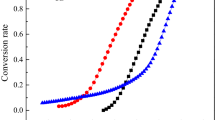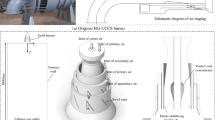Abstract
A commercial CFD package coupled with user-defined functions was used to observe coal particle combustion and tracking, particle capturing and deposition, and other related phenomena. A modified Watt-Fereday model for deposition employing experimental coefficients derived from the ash fusion test was used to predict ash viscosity, which showed that the samples had a nonadditive behavior due to the eutectic phenomenon. The furnace results showed that when the Bayan coal, containing a large amount of volatile matters, was injected at the top burner, the slagging propensity increased compared to when it was injected in the bottom burner. In addition, the specific blending ratio of 25 % Flame and 75 % Bayan coal, which had a lower melting temperature compared to the individual coals. This study suggests that sub-bituminous coal should be injected in the bottom burner, and the specific blending ratio that yields a low-temperature eutectic mixture should be avoided.
Similar content being viewed by others
References
J. M. Beér, Combustion technology developments in power generation in response to environmental challenges, Prog. Energy Combust. Sci., 26(4) (2000) 301–327.
H. Lim, S. Lkhagvadorj, C. H. Oh, B. H. Lee and C. H. Jeon, Effect of ash fraction and particle size on ash deposition during pulverized coal combustion, J. Mech. Sci. Tech., 30(7) (2016) 3393–3400.
C. Yongtie, T. Kunlin, Z. Zhimin, Y. Wenming, W. Hui, Z. Guang, L. Zhiwang, S. K. Boon and P. Subbaiah, Modeling of ash formation and deposition processes in coal and biomass fired boilers: A comprehensive review, Appl. Energy, 230 (2018) 1447–1544.
X. Yang, D. Ingham, L. Ma, N. Srinivasan and M. Pourkashanian, Ash deposition propensity of coals/blends combustion in boilers: a modeling analysis based on multi-slagging routes, P. Combust. Inst., 36 (2017) 3341–3350.
H. Lim, S. Lkhagvadorj, S. M. Kim, A. Hoshino, T. Yamashita and C. H. Jeon, The effect of blending of bituminous and sub-bituminous coals on ash fusibility and deposition formation, J. Mech. Sci. Technol., 30(3) (2016) 1413–1420.
Y. Niu, H. Tan and S. Hui, Ash-related issues during biomass combustion: Alkali-induced slagging, silicate melt-induced slagging (ash fusion), agglomeration, corrosion, ash utilization, and related countermeasures, Prog. Energy Combust. Sci., 52 (2016) 1–61.
A. A. Bhuiyan and J. Naser, Modeling of slagging in industrial furnace: a comprehensive review, Procedia Eng., 105 (2015) 512–519.
M. U. Garba, D. B. Ingham, L. Ma, M. U. Degereji, M. Pourkashanian and A. Williams, Modelling of deposit formation and sintering for the co-combustion of coal with biomass, Fuel, 113 (2013) 863–872.
A. Rushdi, R. Gupta, A. Sharma and D. Holcombe, Mechanistic prediction of ash deposition in a pilot-scale test facility, Fuel, 84 (2005) 1246–1258.
T. Heinzel, V. Siegle, H. Spliethoff and K. R. G. Hein, Investigation of slagging in pulverized fuel co-combustion of biomass and coal at pilot-scale test facility, Fuel Process. Technol., 54 (1998) 109–125.
M. U. Degereji, D. B. Ingham, L. Ma, M. Pourkashanian and A. Williams, Prediction of ash slagging propensity in a pulverized coal combustion furnace, Fuel, 101 (2011) 171–178.
Y. Zheng, P. A. Jensen, A. D. Jensen, B. Sander and H. Junker, Ash transformation during co-firing coal and straw, Fuel, 86 (2007) 1008–1020.
X. Wu, Z. Zhang, Y. Chen, T. Zhou, J. Fan, G. Piao, N. Kobayashi, S. Mori and Y. Itaya, Main mineral melting behavior and mineral reaction mechanism at molecular level of blended coal ash under gasification condition, Fuel Process. Technol., 91 (2010) 1591–1600.
C. Wang, Y. Liu, X. Zhang and D. Che, A study on coal properties and combustion characteristics of blended coals in Northwestern China, Energy Fuels, 25 (2011) 3634–3645.
J. R. Qiu, F. Li, Y. Zheng, C. G. Zheng and H. C. Zhou, The influences of mineral behaviour on blended coal ash fusion characteristics, Fuel, 78 (1999) 963–969.
A. Lawrence, R. Kumar, K. Nandakumar and K. Narayanan, A novel tool for assessing slagging propensity of coals in PF boiler, Fuel, 87 (2008) 946–950.
A. R. McLennan, G. W. Bryant, C. W. Bailey, B. R. Stanmore and T. F. Wall, Index for iron-based slagging for pulverized coal firing in oxidizing and reducing conditions, Energy Fuel, 14 (2000) 349–354.
J. D. Watt and F. Fereday, The flow properties of slag formed from the ashes of British coals: Part 1: viscosity of homogeneous liquid slag in relation to slag composition, J. Inst. Fuel, 42 (1969) 99–103.
H. Spliethoff, Power Generation from Solid Fuels, ISBN 978-3-642-02856-4 (2010).
E. Raask, Mineral Impurities in Coal Combustion: Behavior, Problems, and Remedial Measures, Hemisphere Publishing Corporation, ISBN 3-540-13817-X (1985).
L. Y. Huang, J. S. Norman, M. Pourkashanian and A. Williams, Prediction of ash deposition on superheater tubes from pulverized coal combustion, Fuel, 75(3) (1996) 271–279.
S. Badzioch and P. G. W. Hawksley, Kinetics of thermal decomposition of pulverized coal particles, Ind. Eng. Chem. Process. Des. Dev., 9 (1970) 521–530.
L. Ma, M. Gharebaghi, R. Porter, M. Pourkashanian, J. M. Jones and A. Williams, Modelling methods for co-fired pulverised fuel furnaces, Fuel, 88 (2009) 2448–2454.
Y. Hua, H. Li and J. Yan, Numerical investigation of heat transfer characteristics in utility boilers of oxy-coal combustion, Applied Energy, 130 (2014) 543–551.
B. F. Magnussen and B. H. Hjertager, On mathematical modeling of turbulent combustion with special emphasis on soot formation and combustion, Proc. Combust. Inst., 16 (1977) 719–729.
R. I. Backreedy, L. M. Fletcher, L. Ma, M. Pourkashanian and A. Williams, Modelling pulverised coal combustion using a detailed coal combustion model, Combust. Sci. Technol., 178 (2006) 763–787.
A. Sadiki, S. Agrebi, M. Chrigui, A. S. Doost, R. Knappstein, F. Di Mare, J. Janicka, A. Massmeyer, D. Zabrodiec, J. Hees and R. Kneer, Analyzing the effects of turbulence and multiphase treatments on oxy-coal combustion process predictions using LES and RANS, Chemical Engineering Science, 166 (2017) 283–302.
R. Žajdlik, L’. Jelemenský, J. Markos and B. Remiarová, Modelling of gasification of a single coal char particle, Chem. Pap., 55(6) (2001) 364–368.
J. Guo, F. Hu, X. Jiang, X. Huang, P. Li, Z. Liu and C. Zheng, Experimental and numerical investigations on heat transfer characteristics of a 35MW oxy-fuel combustion boiler, Energy Procedia, 114 (2017) 481–489.
B. Kuan, N. Rea and M. P. Schwarz, Application of CFD in the design of a grit collection system for the coal-fired power generation industry, Powder Technol., 179 (2007) 65–72.
A. Brink, D. Lindberg, M. Hupa, M. E. Tejada, M. Paneru, J. Maier, G. Scheffknecht, A. Pranzitelli and M. Pourkashanian, A temperature-history based model for the sticking probability of impacting pulverized coal ash particles, Fuel Process. Technol., 141 (2016) 210–215.
R. Weber, M. Mancini, N. S. Mancini and T. Kupka, On predicting the ash behavior using computational fluid dynamics, Fuel Process. Technol., 105 (2013) 113–128.
P. P. Płaza, The development of a slagging and fouling predictive methodology for large scale pulverised boilers fired with coal/biomass blends, Ph.D. Thesis, Cardiff University (2013).
T. Kupka, Ash deposition problems during co-firing of alternative fuels in coal-fired power plants, Clausthal-Zellerfeld, Ph.D. Thesis, Clausthal University of Technology (2009).
R. Israel and D. E. Rosner, Use of generalized stokes number to determine the aerodynamic capture efficiency of non-stokesian particles from a compressible gas flow, Aerosol Sci. Tech., 1 (1983) 45–51.
M. Shen, K. Qiu, L. Zhang, Z. Huang, Z. Wang and J. Liu, Influence of coal blending on ash fusibility in reducing atmosphere, Energies, 8 (2015) 4735–4754.
P. Xing, L. I. Darvell, J. M. Jones, L. Ma, M. Pourkashanian and A. Williams, Experimental and theoretical methods for evaluating ash properties of pine and El Cerrejon coal used in co-firing, Fuel, 183 (2016) 39–54.
M. Kutz, Mechanical Engineers’ Handbook, Volume 4: Energy and Power, Hoboken: John Wiley & Sons (2014).
G. H. Richards, P. N. Slater and J. N. Harb, Simulation of ash deposit growth in a pulverized coal-fired pilot-scale reactor, Energy Fuels, 7 (1993) 774–781.
S. Li, Y. Wu and K. J. Whitty, Ash deposition behavior during char-slag transition under simulated gasification conditions, Energy Fuels, 24 (2010) 1868–1876.
F. Li, M. Li, H. Fan and Y. Fang, Understanding ash fusion and viscosity variation from coal blending based on mineral interaction, Energy Fuels, 32 (2018) 132–141.
Acknowledgments
This work was supported by the R&D fund of Doosan Heavy Industries & Construction.
Author information
Authors and Affiliations
Corresponding author
Additional information
Byoung-Hwa Lee received his B.S. degree in Mechanical Engineering from Korea Maritime University in 2003. He received his Ph.D. degree from Pusan National University in 2011. He is currently a principal research engineer at Corporate R&D Institute of Doosan Heavy Industries & Construction.
Joong-Hyun Lim received his B.S. degree in Mechanical Engineering from Yonsei University in 2012. He is currently a senior research engineer at Corporate R&D Institute of Doosan Heavy Industries & Construction.
Rights and permissions
About this article
Cite this article
Lee, BH., Lim, JH. Impact of blending ratio and injection position on slagging behavior in a 1000 MWe wall-fired furnace with a modified viscosity model. J Mech Sci Technol 34, 4841–4856 (2020). https://doi.org/10.1007/s12206-020-1040-4
Received:
Revised:
Accepted:
Published:
Issue Date:
DOI: https://doi.org/10.1007/s12206-020-1040-4




